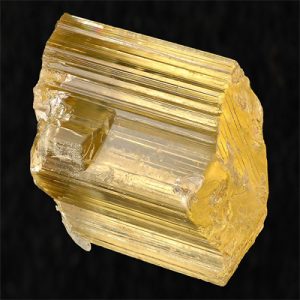Marialite
Marialite is a silicate mineral that was first described in 1866 for an occurrence in the Phlegrean Volcanic complex, Campania, Italy. It was named in 1866 by German mineralogist Gerhard vom Rath in honor of his wife, Maria Rosa vom Rath. It is a member of the Scapolite Group of minerals that includes Kembleite, Marialite, Meionite, and Silvialie. Marialite also belongs to the Marialite-Meionite series. Marialite is the sodium chloride rich end member and Meionite is the calcium carbonate-rich end member with Wernerite as a possible intermediate member of the series. Although Wernerite is mostly an obsolete name now it may be deserving of species status (see Dana, 8th Ed.).
Scapolite is generally used as a mineral species name but actually refers to the Marialite-Meionite series, not an individual mineral name or the full Scapolite Group, so excludes Kembleite and Silvialite. The name Scapolite is now often used as a generic term when the exact chemical composition of a specimen in the Marialite-Meionite solid solution series has not been determined. Distinguishing the Scapolite minerals from each other is difficult as they differ only slightly in density and index of refraction, increasing in both with increasing calcium content. It is because of this closeness in properties and yet seemingly very different chemistries that Scapolite has had its share of pseudonyms. Wernerite was the most common alternate name for the Scapolite series, but now it has mostly disappeared from use. A few other names such as Mizzonite and Dipyre as well as Marialite and Meionite have been used as names for the entire Scapolite series.
Marialite is formed in high pressure and/or high-temperature environments. Scapolite Group minerals typically form in metamorphic rocks from the alteration of Plagioclase Feldspars.
Most specimens are intermediate in the series; some localities for highly sodic materials include: at Pianura, west of Naples, Campania, Italy. From Russia, in the Slyudyanka region, near Lake Baikal, Siberia. In the USA, at Hamburg and Franklin, Sussex County, New Jersey; at Natural Bridge, Je®erson County, Macomb, St. Lawrence County, and Olmsteadville, Essex County, New York; from French Creek, Chester County, Pennsylvania. In Canada, at Bear Lake, Pontiac County, Quebec, and Bancroft, Ontario. From the La Panchita mine, near Ayoquezco, Oaxaca, Mexico. From Serra da Chibita, Rio Pardo, Minas Gerais, Brazil. At Tsarasaotra and Betroka, Madagascar. From Mpwapwa, Morogoro region, Dodoma, Tanzania. In the Mogok district, Myanmar (Burma).
| Category: | Tectosilicate |
| Chemical Formula: | Na4Al3Si9O24Cl |
| Sodium Aluminum Silicate Cloride | |
| Molecular Weight: | 845.11 gm |
| Composition: | Sodium | 10.88 % | Na | 14.67 % | Na2O |
| Aluminum | 9.58 % | Al | 18.10 % | Al2O3 | |
| Silicon | 29.91 % | Si | 63.99 % | SiO2 | |
| Chlorine | 4.20 % | Cl | 4.20 % | Cl | |
| – | Cl | -0.95 % | -O=Cl2 | ||
| Oxygen | 45.44 % | O | |||
| 100.00 % | 100.00 % | = TOTAL OXIDE |
| Crystallography: | Tetragonal – Dipyramidal |
| Crystal Habit: | TCrystals prismatic, typically with flat pyramidal terminations, striated || [001], to 1.5 m; granular, massive. |
| Twinning: | None |
| Cleavage: | Distinct on {100} and {110} |
| Fracture: | Irregular/uneven, conchoidal |
| Tenacity: | Very brittle |
| Moh’s Hardness: | 5.5 – 6.0 |
| Density: | 2.50 – 2.62 (g/cm3) |
| Luminescence: | Commonly fluoresces orange to bright yellow or red under SW and/or LW UV light. |
| Radioactivity: | Not Radioactive |
| Color: | Colorless, white, grey; pink, violet, blue, yellow, brown, orange-brown; colorless in thin section. |
| Transparency: | Transparent to opaque |
| Luster: | Vitreous, pearly, resinous |
| Refractive Index: | 1.532 – 1.550 Uniaxial ( – ) |
| Birefringence: | 0.007 – 0.009 |
| Dispersion: | n/a |
| Pleochroism: | None |


